Visual Arts: Baroque and Modern Era
VerifiedAdded on 2023/05/29
|10
|1462
|466
AI Summary
This article discusses the Baroque and Modern Era of Visual Arts. It covers the famous painters, styles, and characteristics of each era. It also explores the influence of art history on modern design through various examples.
Contribute Materials
Your contribution can guide someone’s learning journey. Share your
documents today.

Running head: VISUAL ARTS
VISUAL ARTS
Name of the Student:
Name of the University:
Author Note:
VISUAL ARTS
Name of the Student:
Name of the University:
Author Note:
Secure Best Marks with AI Grader
Need help grading? Try our AI Grader for instant feedback on your assignments.
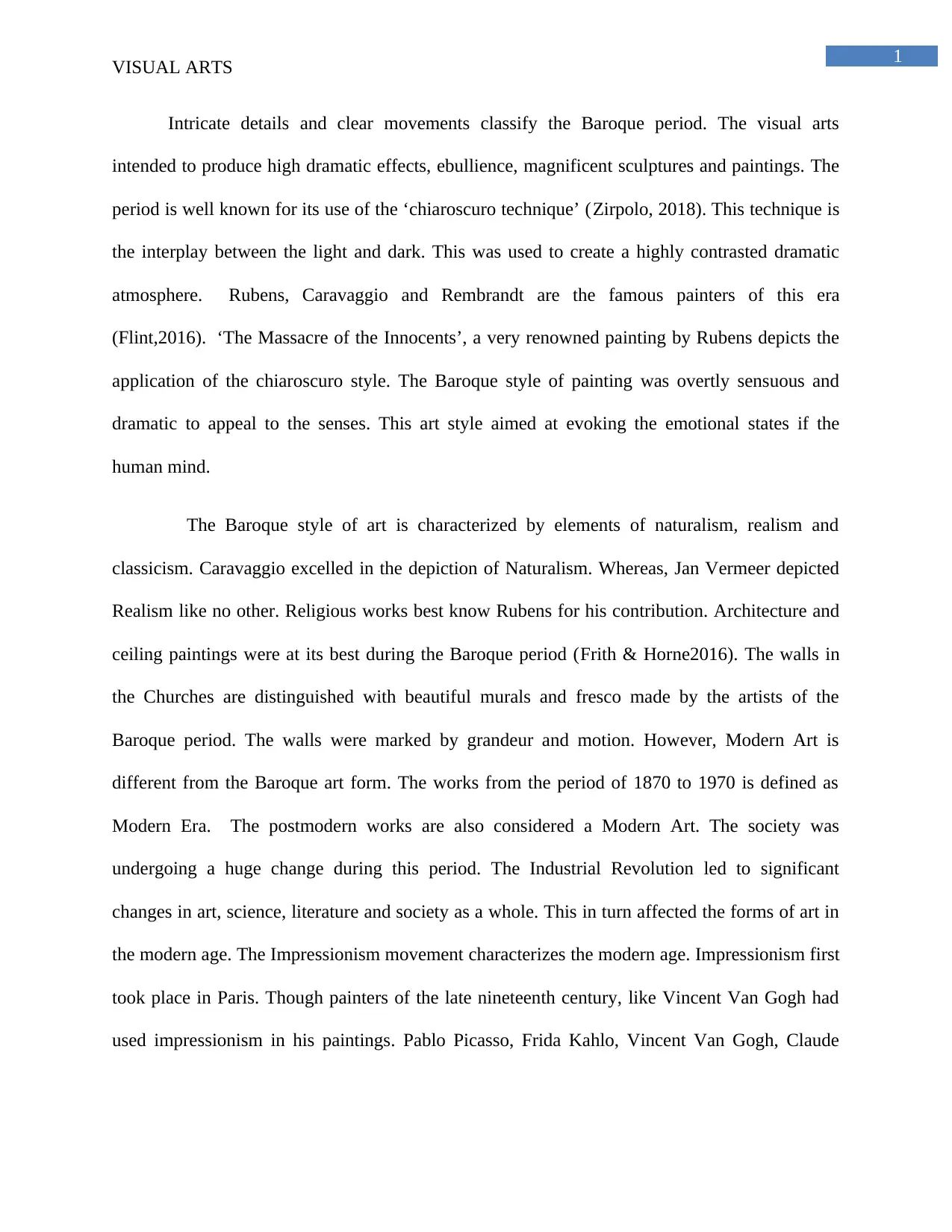
1
VISUAL ARTS
Intricate details and clear movements classify the Baroque period. The visual arts
intended to produce high dramatic effects, ebullience, magnificent sculptures and paintings. The
period is well known for its use of the ‘chiaroscuro technique’ (Zirpolo, 2018). This technique is
the interplay between the light and dark. This was used to create a highly contrasted dramatic
atmosphere. Rubens, Caravaggio and Rembrandt are the famous painters of this era
(Flint,2016). ‘The Massacre of the Innocents’, a very renowned painting by Rubens depicts the
application of the chiaroscuro style. The Baroque style of painting was overtly sensuous and
dramatic to appeal to the senses. This art style aimed at evoking the emotional states if the
human mind.
The Baroque style of art is characterized by elements of naturalism, realism and
classicism. Caravaggio excelled in the depiction of Naturalism. Whereas, Jan Vermeer depicted
Realism like no other. Religious works best know Rubens for his contribution. Architecture and
ceiling paintings were at its best during the Baroque period (Frith & Horne2016). The walls in
the Churches are distinguished with beautiful murals and fresco made by the artists of the
Baroque period. The walls were marked by grandeur and motion. However, Modern Art is
different from the Baroque art form. The works from the period of 1870 to 1970 is defined as
Modern Era. The postmodern works are also considered a Modern Art. The society was
undergoing a huge change during this period. The Industrial Revolution led to significant
changes in art, science, literature and society as a whole. This in turn affected the forms of art in
the modern age. The Impressionism movement characterizes the modern age. Impressionism first
took place in Paris. Though painters of the late nineteenth century, like Vincent Van Gogh had
used impressionism in his paintings. Pablo Picasso, Frida Kahlo, Vincent Van Gogh, Claude
VISUAL ARTS
Intricate details and clear movements classify the Baroque period. The visual arts
intended to produce high dramatic effects, ebullience, magnificent sculptures and paintings. The
period is well known for its use of the ‘chiaroscuro technique’ (Zirpolo, 2018). This technique is
the interplay between the light and dark. This was used to create a highly contrasted dramatic
atmosphere. Rubens, Caravaggio and Rembrandt are the famous painters of this era
(Flint,2016). ‘The Massacre of the Innocents’, a very renowned painting by Rubens depicts the
application of the chiaroscuro style. The Baroque style of painting was overtly sensuous and
dramatic to appeal to the senses. This art style aimed at evoking the emotional states if the
human mind.
The Baroque style of art is characterized by elements of naturalism, realism and
classicism. Caravaggio excelled in the depiction of Naturalism. Whereas, Jan Vermeer depicted
Realism like no other. Religious works best know Rubens for his contribution. Architecture and
ceiling paintings were at its best during the Baroque period (Frith & Horne2016). The walls in
the Churches are distinguished with beautiful murals and fresco made by the artists of the
Baroque period. The walls were marked by grandeur and motion. However, Modern Art is
different from the Baroque art form. The works from the period of 1870 to 1970 is defined as
Modern Era. The postmodern works are also considered a Modern Art. The society was
undergoing a huge change during this period. The Industrial Revolution led to significant
changes in art, science, literature and society as a whole. This in turn affected the forms of art in
the modern age. The Impressionism movement characterizes the modern age. Impressionism first
took place in Paris. Though painters of the late nineteenth century, like Vincent Van Gogh had
used impressionism in his paintings. Pablo Picasso, Frida Kahlo, Vincent Van Gogh, Claude
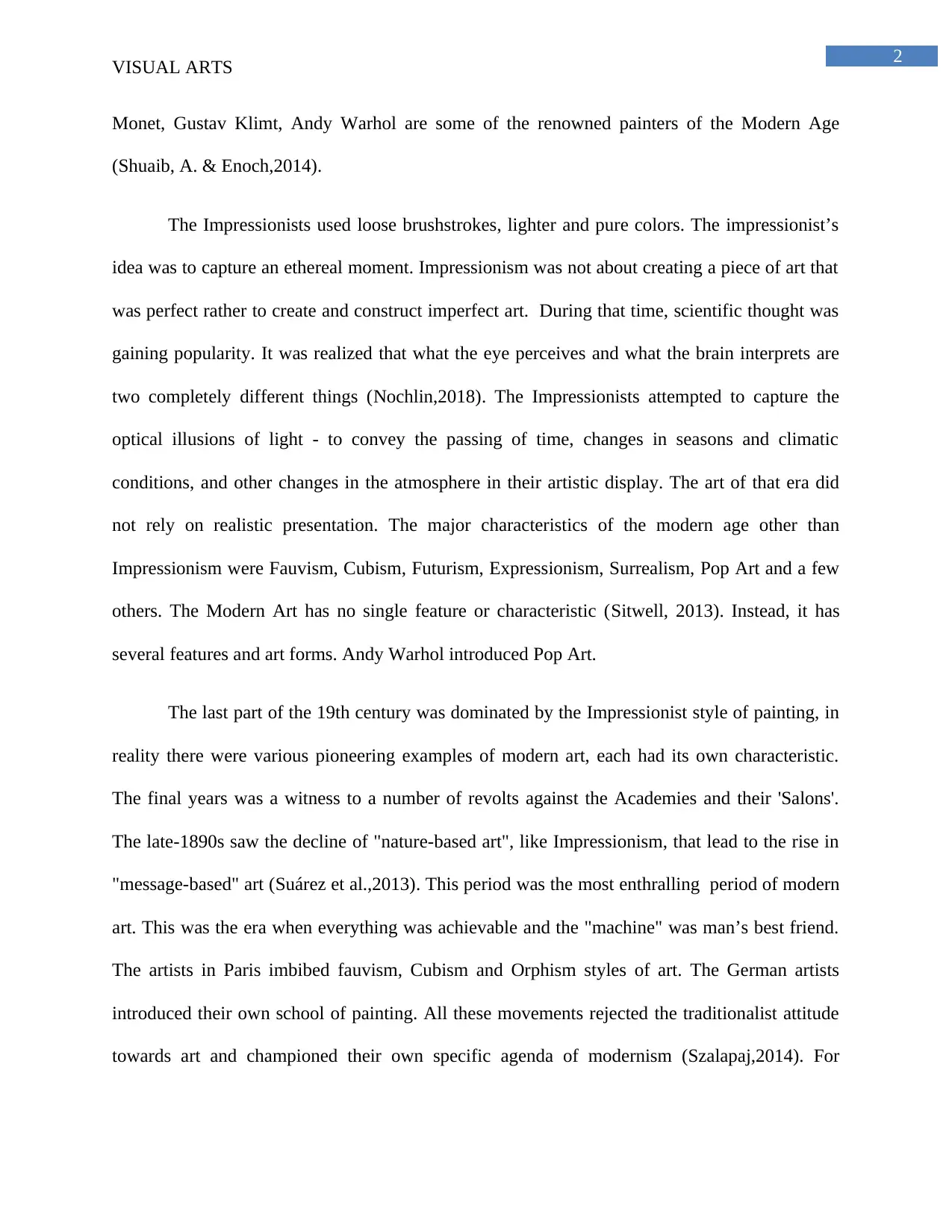
2
VISUAL ARTS
Monet, Gustav Klimt, Andy Warhol are some of the renowned painters of the Modern Age
(Shuaib, A. & Enoch,2014).
The Impressionists used loose brushstrokes, lighter and pure colors. The impressionist’s
idea was to capture an ethereal moment. Impressionism was not about creating a piece of art that
was perfect rather to create and construct imperfect art. During that time, scientific thought was
gaining popularity. It was realized that what the eye perceives and what the brain interprets are
two completely different things (Nochlin,2018). The Impressionists attempted to capture the
optical illusions of light - to convey the passing of time, changes in seasons and climatic
conditions, and other changes in the atmosphere in their artistic display. The art of that era did
not rely on realistic presentation. The major characteristics of the modern age other than
Impressionism were Fauvism, Cubism, Futurism, Expressionism, Surrealism, Pop Art and a few
others. The Modern Art has no single feature or characteristic (Sitwell, 2013). Instead, it has
several features and art forms. Andy Warhol introduced Pop Art.
The last part of the 19th century was dominated by the Impressionist style of painting, in
reality there were various pioneering examples of modern art, each had its own characteristic.
The final years was a witness to a number of revolts against the Academies and their 'Salons'.
The late-1890s saw the decline of "nature-based art", like Impressionism, that lead to the rise in
"message-based" art (Suárez et al.,2013). This period was the most enthralling period of modern
art. This was the era when everything was achievable and the "machine" was man’s best friend.
The artists in Paris imbibed fauvism, Cubism and Orphism styles of art. The German artists
introduced their own school of painting. All these movements rejected the traditionalist attitude
towards art and championed their own specific agenda of modernism (Szalapaj,2014). For
VISUAL ARTS
Monet, Gustav Klimt, Andy Warhol are some of the renowned painters of the Modern Age
(Shuaib, A. & Enoch,2014).
The Impressionists used loose brushstrokes, lighter and pure colors. The impressionist’s
idea was to capture an ethereal moment. Impressionism was not about creating a piece of art that
was perfect rather to create and construct imperfect art. During that time, scientific thought was
gaining popularity. It was realized that what the eye perceives and what the brain interprets are
two completely different things (Nochlin,2018). The Impressionists attempted to capture the
optical illusions of light - to convey the passing of time, changes in seasons and climatic
conditions, and other changes in the atmosphere in their artistic display. The art of that era did
not rely on realistic presentation. The major characteristics of the modern age other than
Impressionism were Fauvism, Cubism, Futurism, Expressionism, Surrealism, Pop Art and a few
others. The Modern Art has no single feature or characteristic (Sitwell, 2013). Instead, it has
several features and art forms. Andy Warhol introduced Pop Art.
The last part of the 19th century was dominated by the Impressionist style of painting, in
reality there were various pioneering examples of modern art, each had its own characteristic.
The final years was a witness to a number of revolts against the Academies and their 'Salons'.
The late-1890s saw the decline of "nature-based art", like Impressionism, that lead to the rise in
"message-based" art (Suárez et al.,2013). This period was the most enthralling period of modern
art. This was the era when everything was achievable and the "machine" was man’s best friend.
The artists in Paris imbibed fauvism, Cubism and Orphism styles of art. The German artists
introduced their own school of painting. All these movements rejected the traditionalist attitude
towards art and championed their own specific agenda of modernism (Szalapaj,2014). For
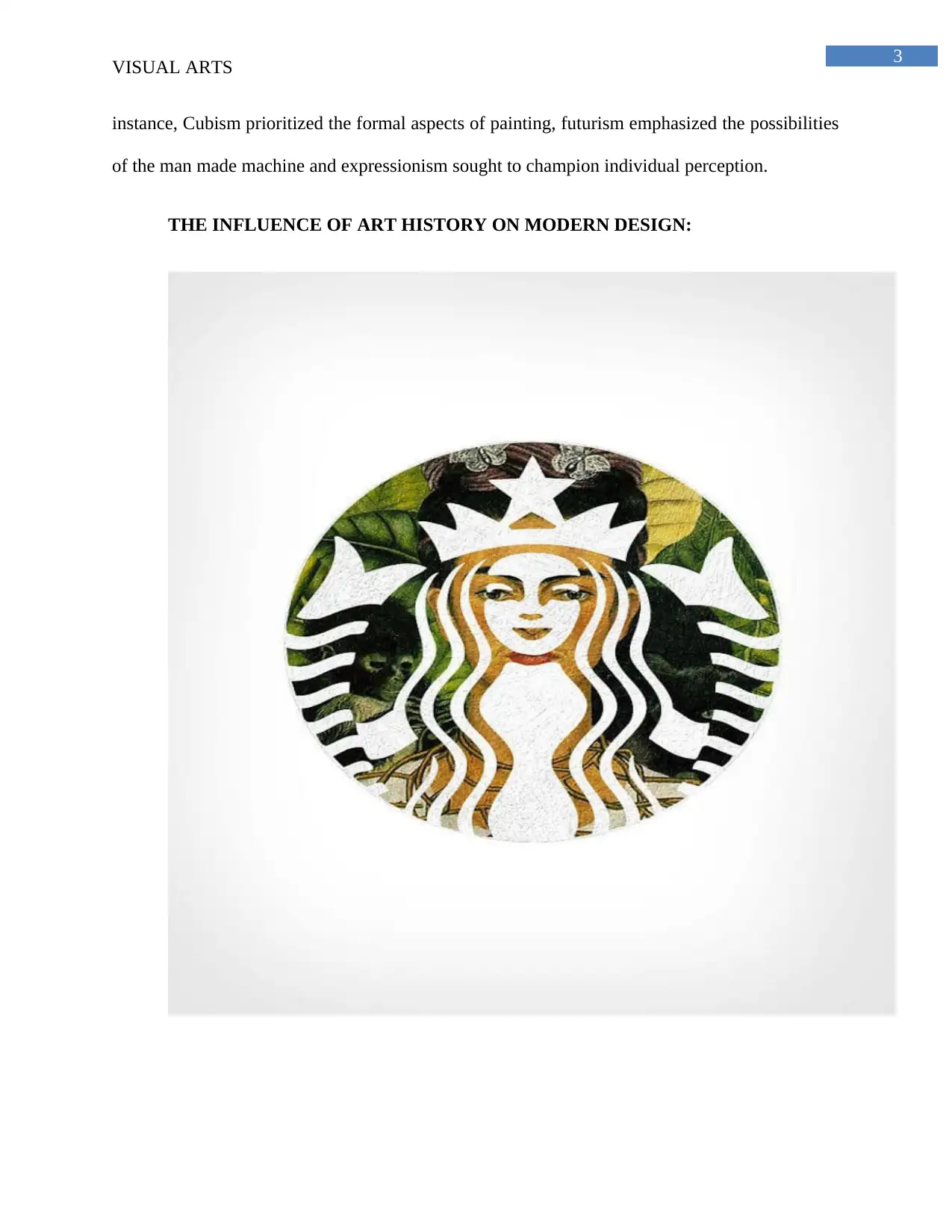
3
VISUAL ARTS
instance, Cubism prioritized the formal aspects of painting, futurism emphasized the possibilities
of the man made machine and expressionism sought to champion individual perception.
THE INFLUENCE OF ART HISTORY ON MODERN DESIGN:
VISUAL ARTS
instance, Cubism prioritized the formal aspects of painting, futurism emphasized the possibilities
of the man made machine and expressionism sought to champion individual perception.
THE INFLUENCE OF ART HISTORY ON MODERN DESIGN:
Secure Best Marks with AI Grader
Need help grading? Try our AI Grader for instant feedback on your assignments.

4
VISUAL ARTS
The renowned Pop artist Eisen Bernardo in his Logo + Art series inlays
famous works of art with contemporary and commercial designs.
In this piece of art, Bernardo combines Frida Kahlo’s Self-portrait with Thorn
Necklace and Hummingbird with Starbucks’s two-tailed siren.
VISUAL ARTS
The renowned Pop artist Eisen Bernardo in his Logo + Art series inlays
famous works of art with contemporary and commercial designs.
In this piece of art, Bernardo combines Frida Kahlo’s Self-portrait with Thorn
Necklace and Hummingbird with Starbucks’s two-tailed siren.
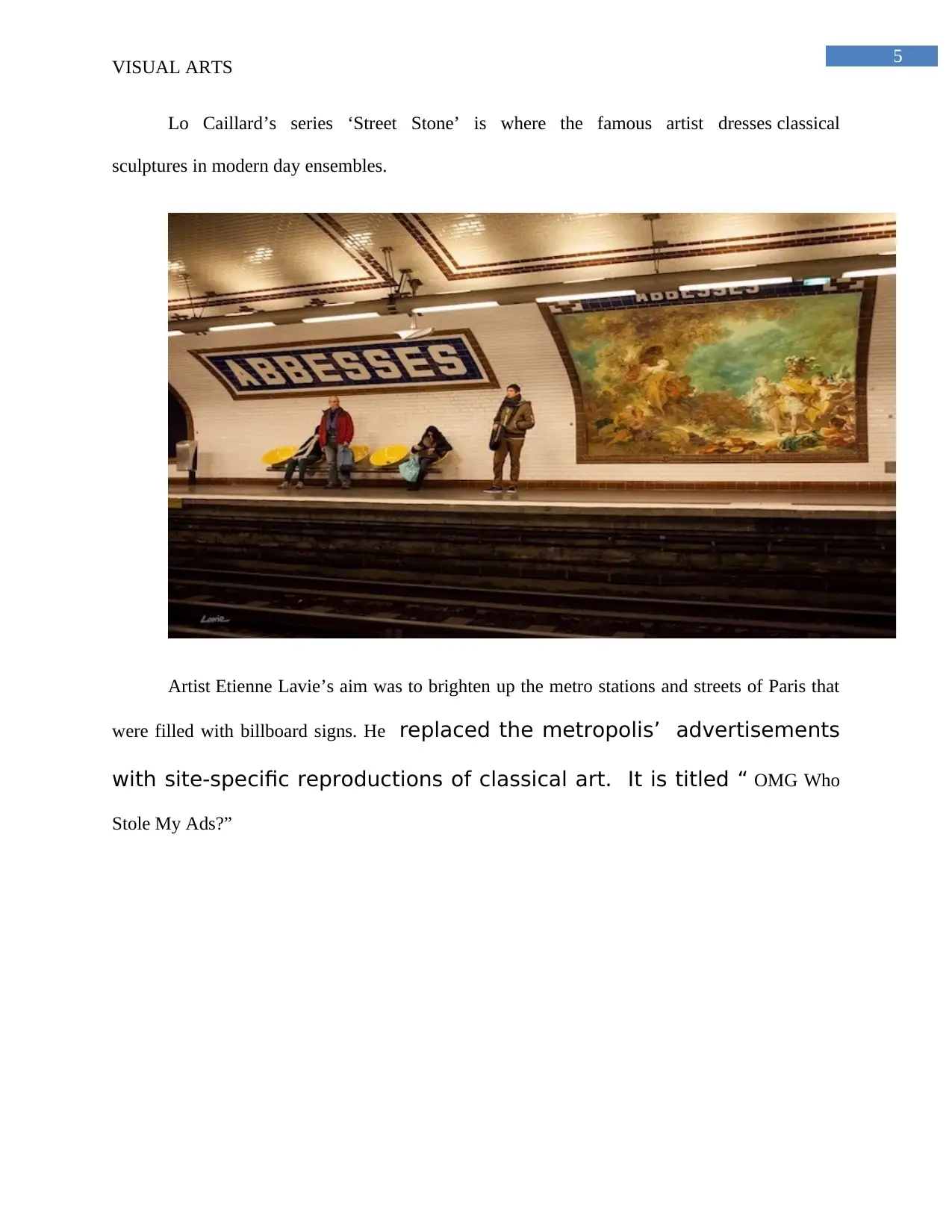
5
VISUAL ARTS
Lo Caillard’s series ‘Street Stone’ is where the famous artist dresses classical
sculptures in modern day ensembles.
Artist Etienne Lavie’s aim was to brighten up the metro stations and streets of Paris that
were filled with billboard signs. He replaced the metropolis’ advertisements
with site-specific reproductions of classical art. It is titled “ OMG Who
Stole My Ads?”
VISUAL ARTS
Lo Caillard’s series ‘Street Stone’ is where the famous artist dresses classical
sculptures in modern day ensembles.
Artist Etienne Lavie’s aim was to brighten up the metro stations and streets of Paris that
were filled with billboard signs. He replaced the metropolis’ advertisements
with site-specific reproductions of classical art. It is titled “ OMG Who
Stole My Ads?”
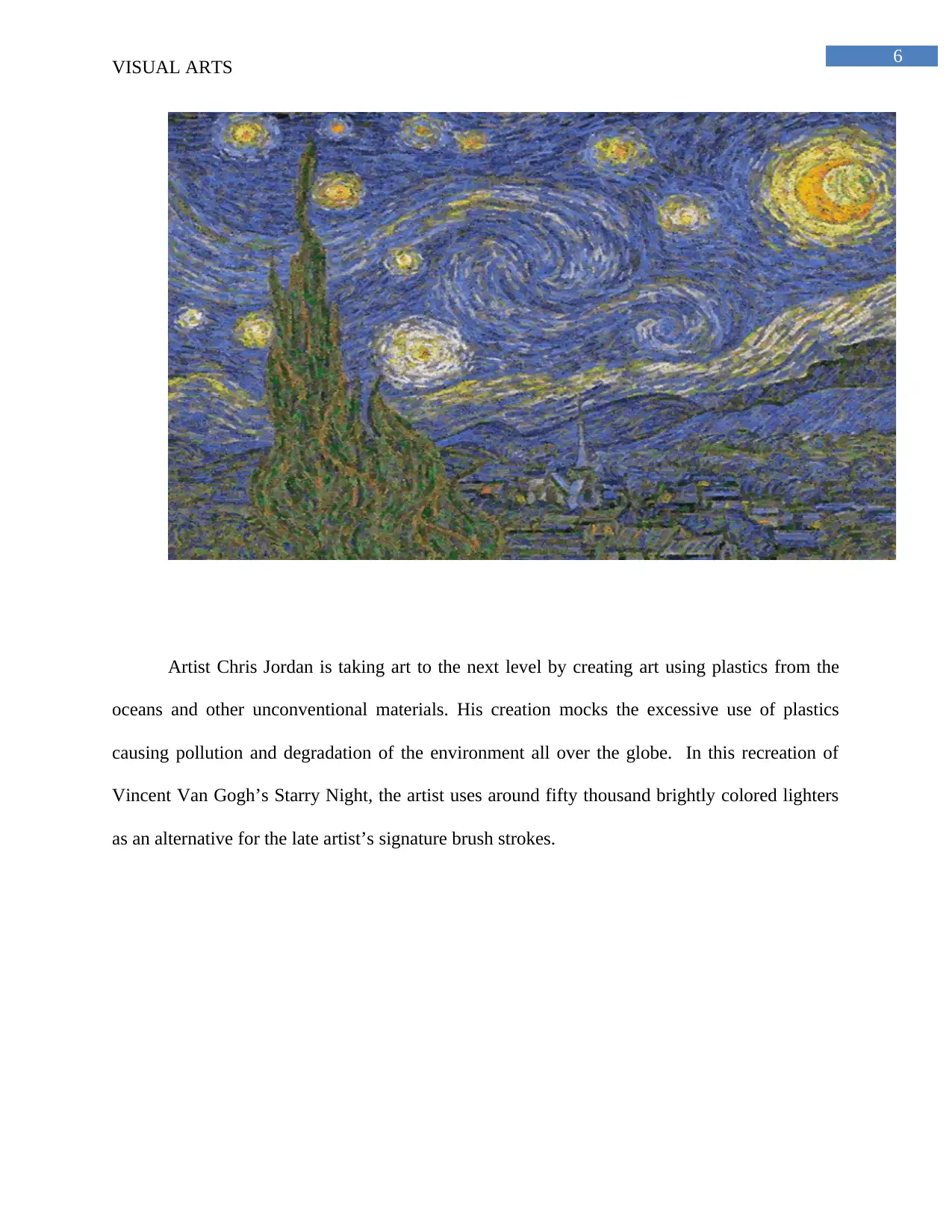
6
VISUAL ARTS
Artist Chris Jordan is taking art to the next level by creating art using plastics from the
oceans and other unconventional materials. His creation mocks the excessive use of plastics
causing pollution and degradation of the environment all over the globe. In this recreation of
Vincent Van Gogh’s Starry Night, the artist uses around fifty thousand brightly colored lighters
as an alternative for the late artist’s signature brush strokes.
VISUAL ARTS
Artist Chris Jordan is taking art to the next level by creating art using plastics from the
oceans and other unconventional materials. His creation mocks the excessive use of plastics
causing pollution and degradation of the environment all over the globe. In this recreation of
Vincent Van Gogh’s Starry Night, the artist uses around fifty thousand brightly colored lighters
as an alternative for the late artist’s signature brush strokes.
Paraphrase This Document
Need a fresh take? Get an instant paraphrase of this document with our AI Paraphraser
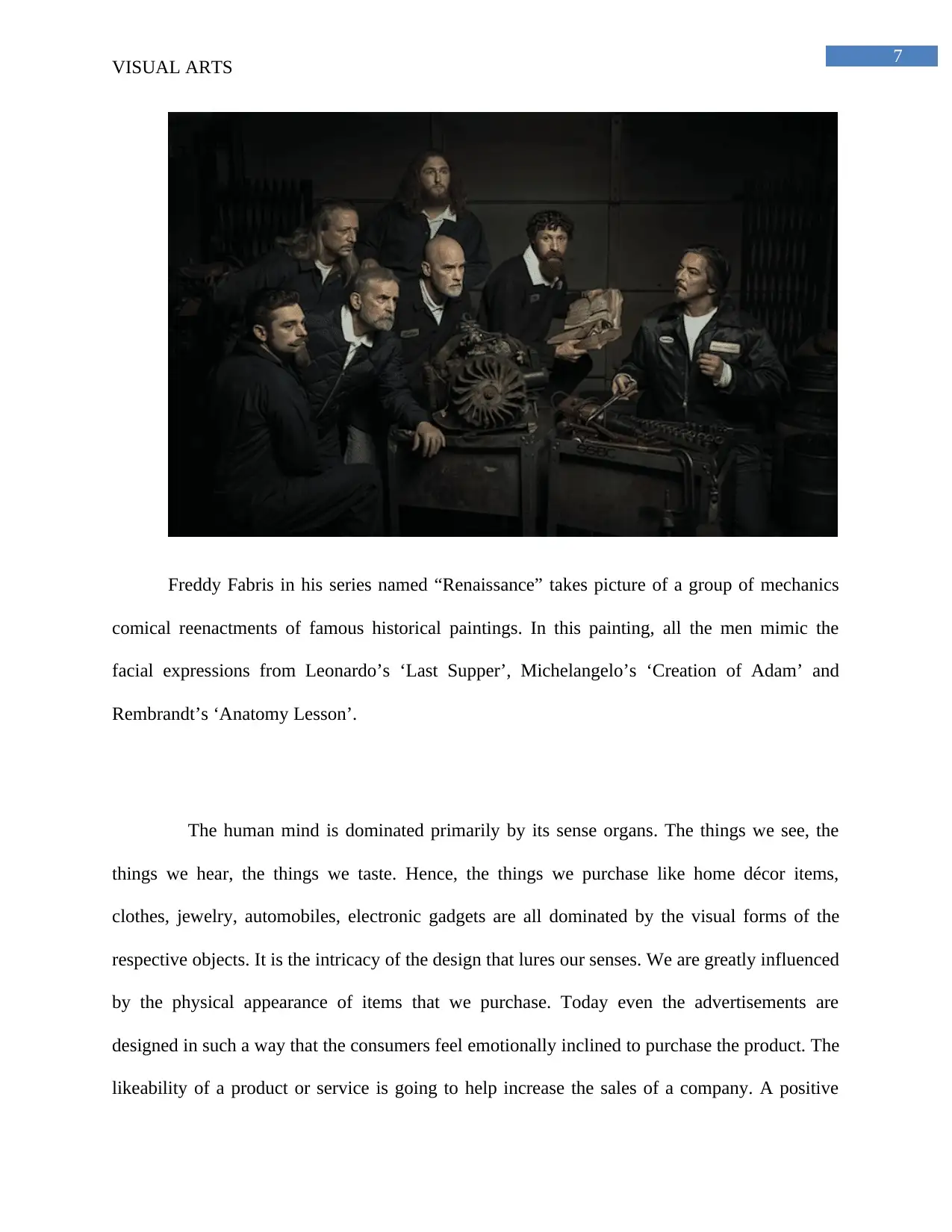
7
VISUAL ARTS
Freddy Fabris in his series named “Renaissance” takes picture of a group of mechanics
comical reenactments of famous historical paintings. In this painting, all the men mimic the
facial expressions from Leonardo’s ‘Last Supper’, Michelangelo’s ‘Creation of Adam’ and
Rembrandt’s ‘Anatomy Lesson’.
The human mind is dominated primarily by its sense organs. The things we see, the
things we hear, the things we taste. Hence, the things we purchase like home décor items,
clothes, jewelry, automobiles, electronic gadgets are all dominated by the visual forms of the
respective objects. It is the intricacy of the design that lures our senses. We are greatly influenced
by the physical appearance of items that we purchase. Today even the advertisements are
designed in such a way that the consumers feel emotionally inclined to purchase the product. The
likeability of a product or service is going to help increase the sales of a company. A positive
VISUAL ARTS
Freddy Fabris in his series named “Renaissance” takes picture of a group of mechanics
comical reenactments of famous historical paintings. In this painting, all the men mimic the
facial expressions from Leonardo’s ‘Last Supper’, Michelangelo’s ‘Creation of Adam’ and
Rembrandt’s ‘Anatomy Lesson’.
The human mind is dominated primarily by its sense organs. The things we see, the
things we hear, the things we taste. Hence, the things we purchase like home décor items,
clothes, jewelry, automobiles, electronic gadgets are all dominated by the visual forms of the
respective objects. It is the intricacy of the design that lures our senses. We are greatly influenced
by the physical appearance of items that we purchase. Today even the advertisements are
designed in such a way that the consumers feel emotionally inclined to purchase the product. The
likeability of a product or service is going to help increase the sales of a company. A positive
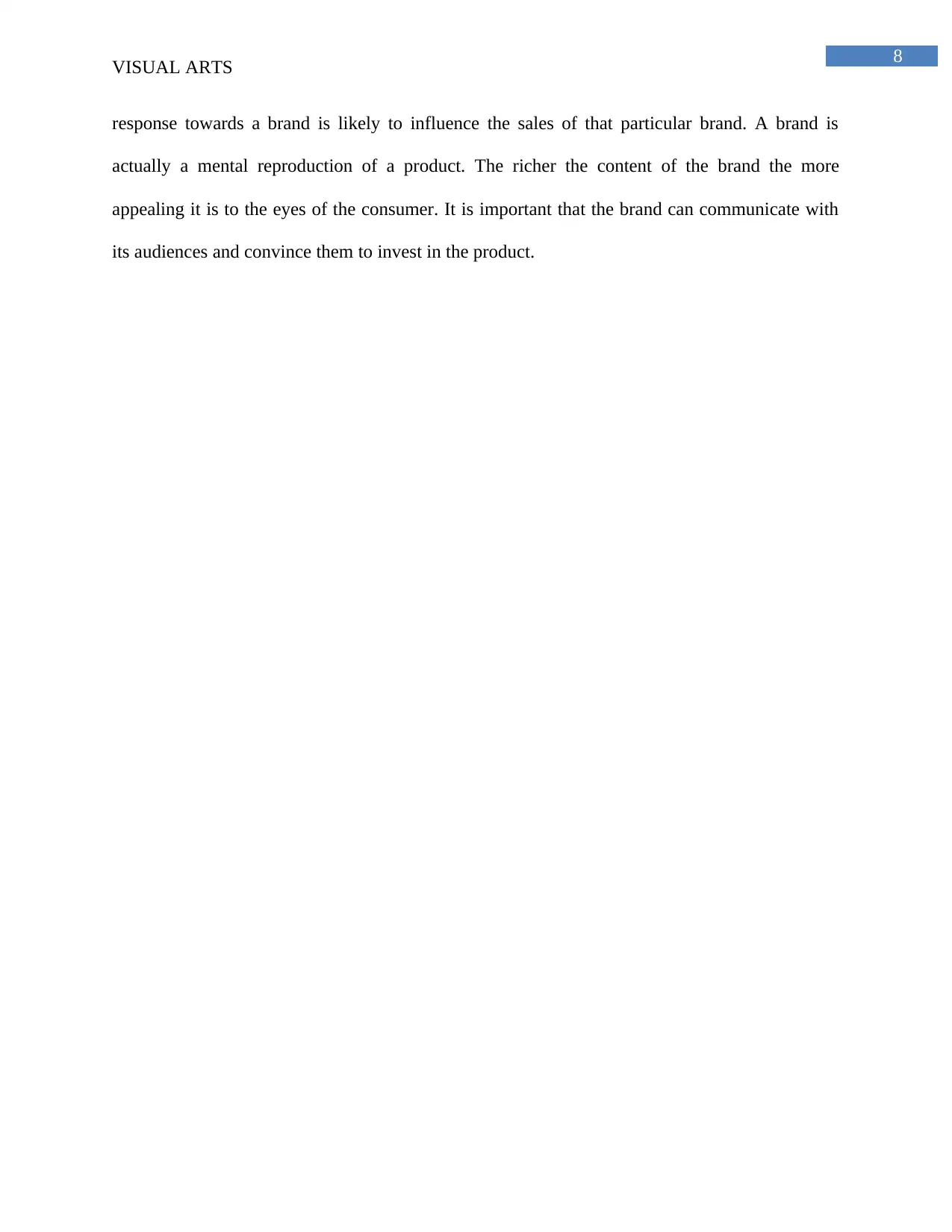
8
VISUAL ARTS
response towards a brand is likely to influence the sales of that particular brand. A brand is
actually a mental reproduction of a product. The richer the content of the brand the more
appealing it is to the eyes of the consumer. It is important that the brand can communicate with
its audiences and convince them to invest in the product.
VISUAL ARTS
response towards a brand is likely to influence the sales of that particular brand. A brand is
actually a mental reproduction of a product. The richer the content of the brand the more
appealing it is to the eyes of the consumer. It is important that the brand can communicate with
its audiences and convince them to invest in the product.
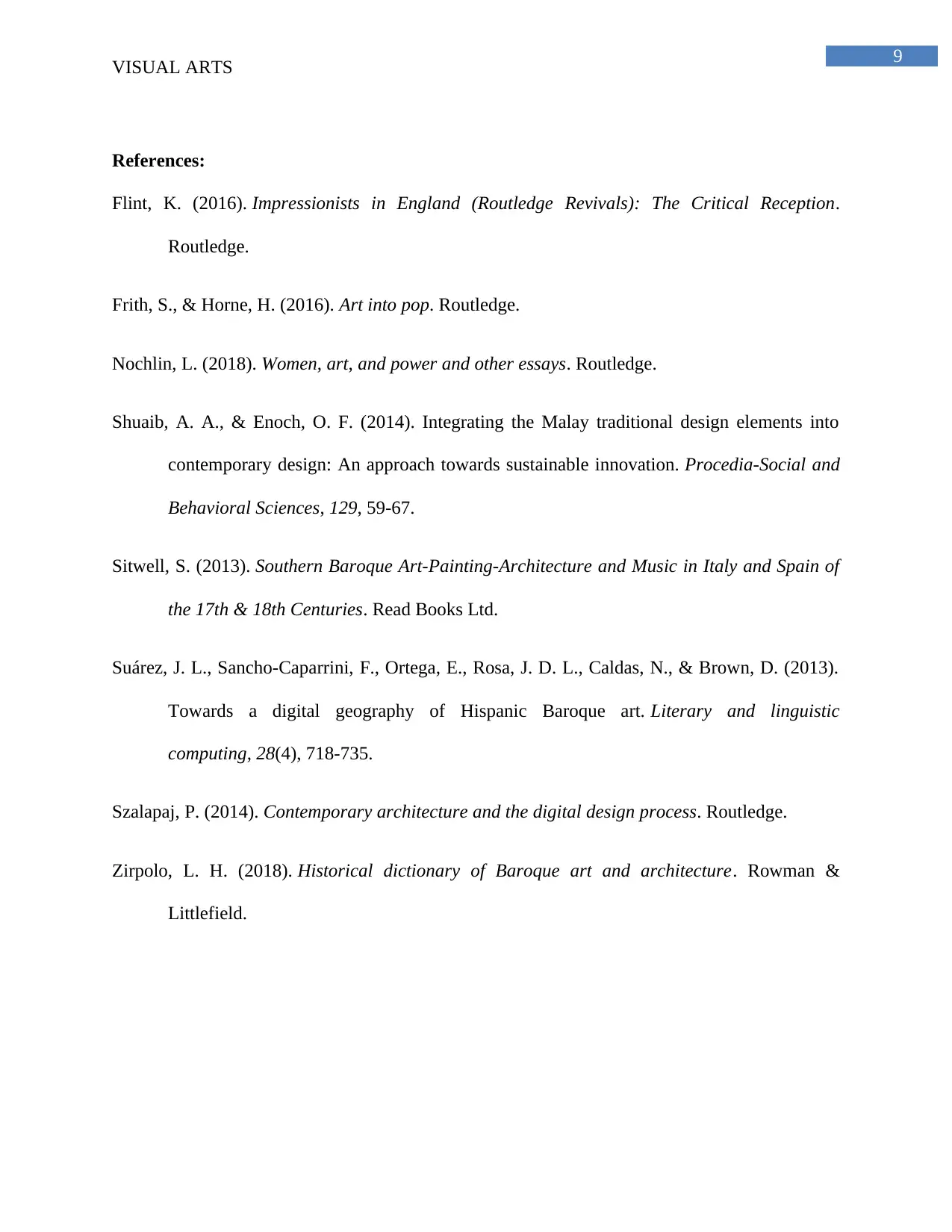
9
VISUAL ARTS
References:
Flint, K. (2016). Impressionists in England (Routledge Revivals): The Critical Reception.
Routledge.
Frith, S., & Horne, H. (2016). Art into pop. Routledge.
Nochlin, L. (2018). Women, art, and power and other essays. Routledge.
Shuaib, A. A., & Enoch, O. F. (2014). Integrating the Malay traditional design elements into
contemporary design: An approach towards sustainable innovation. Procedia-Social and
Behavioral Sciences, 129, 59-67.
Sitwell, S. (2013). Southern Baroque Art-Painting-Architecture and Music in Italy and Spain of
the 17th & 18th Centuries. Read Books Ltd.
Suárez, J. L., Sancho-Caparrini, F., Ortega, E., Rosa, J. D. L., Caldas, N., & Brown, D. (2013).
Towards a digital geography of Hispanic Baroque art. Literary and linguistic
computing, 28(4), 718-735.
Szalapaj, P. (2014). Contemporary architecture and the digital design process. Routledge.
Zirpolo, L. H. (2018). Historical dictionary of Baroque art and architecture. Rowman &
Littlefield.
VISUAL ARTS
References:
Flint, K. (2016). Impressionists in England (Routledge Revivals): The Critical Reception.
Routledge.
Frith, S., & Horne, H. (2016). Art into pop. Routledge.
Nochlin, L. (2018). Women, art, and power and other essays. Routledge.
Shuaib, A. A., & Enoch, O. F. (2014). Integrating the Malay traditional design elements into
contemporary design: An approach towards sustainable innovation. Procedia-Social and
Behavioral Sciences, 129, 59-67.
Sitwell, S. (2013). Southern Baroque Art-Painting-Architecture and Music in Italy and Spain of
the 17th & 18th Centuries. Read Books Ltd.
Suárez, J. L., Sancho-Caparrini, F., Ortega, E., Rosa, J. D. L., Caldas, N., & Brown, D. (2013).
Towards a digital geography of Hispanic Baroque art. Literary and linguistic
computing, 28(4), 718-735.
Szalapaj, P. (2014). Contemporary architecture and the digital design process. Routledge.
Zirpolo, L. H. (2018). Historical dictionary of Baroque art and architecture. Rowman &
Littlefield.
1 out of 10
Related Documents
Your All-in-One AI-Powered Toolkit for Academic Success.
+13062052269
info@desklib.com
Available 24*7 on WhatsApp / Email
![[object Object]](/_next/static/media/star-bottom.7253800d.svg)
Unlock your academic potential
© 2024 | Zucol Services PVT LTD | All rights reserved.




